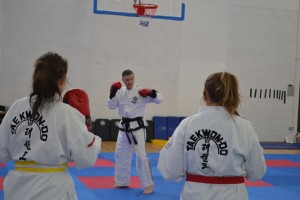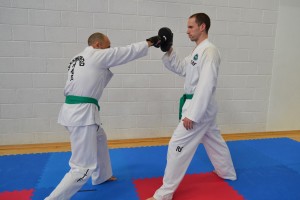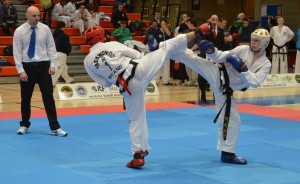The Three Faces of Taekwon-Do
Taekwon-Do may be viewed as a martial art, a sport and of course self defense. As a student of this great art I have at times confused these three faces, and my goal with this article is to highlight and differentiate all three. While the sport and competitive side of Taekwon-Do are self explanatory, many heated debates down through the decades have argued the martial art or self defense issue.
With some exceptions, self defense, the actual ability to defend yourself against an assault or serious threat on your life and learning a martial art are two separate subjects. As a professional Taekwon-Do instructor teaching ITF style Taekwon-Do, I struggle with overlapping demands and like most schools; my students run the gamut from above average students that need regular and consistent challenging, to students with learning difficulties. That gamut also spans from the technical and tactical sparring skills required for competition to the emotional and mental skills that students need to understand and enjoy the benefits of Taekwon-Do.
On top of this there are different age groups and abilities, getting students familiar with the syllabus, remedial work on weaker students, those who need to know exactly what’s required for their next grading and those training specifically for a tournament.
Then I have to make my school profitable by ensuring I recruit and retain as many students as possible each term, all the time maintaining a very high ITF Taekwon-Do standard. Factor in learning self defense and one would have to be a wizard on time management, an expert on floor configuration, have transitions that run smoothly and advanced strategic planning for each term that fit neatly for each and every class. I love the healthy lifestyle, the focus, discipline and respect that come with practicing all three aspects of Taekwon-Do. As a student and instructor especially in my younger days, I held that preconceived notion that once I won a few medals at sparring I could handle myself in the street. In Cork the term they use is “Your man is Handy” if your reputation outside the chip-shop on Saturday night is held in high esteem by local alpha males. This article frowns on this oft held misconception as I feel the need to address the aspect of self defense and all the ugly reality that it entails.
Definition of Self Defense.
Most professionals decry that term self defence. It implies that you first react (defend) to some provocation and only then it’s your turn. Self-Protection would be a better term, implying pro-action as opposed to reaction. Action will always be faster than reaction. For the sake of this article, I will however use the term self defense.
 While I show children basic wrist releases and this activity, we term self defense for want of a better explanation to the kids and their parents, however the self defense I am referring to here is aimed primarily at the older teens and adults in my school. Learning Self Defense with the sole intention of protecting oneself in the street is tough, hard, ugly and violent. It distills the moves that will work best when your back’s against the wall, and having exhausted all possibilities, pre-emptive striking remains the only option. Fight or flight syndrome, fear and adrenaline rush must be fully understood. All the aforementioned as well as a competent skill set in a honed repertoire that suit your body type are all in the self defense tool-box. Finally, and this certainly would not be an exhaustive list, one would benefit with a streetwise attitude and a vocabulary that’s no stranger to profanity if self defense is the goal. All these “skills” lie at variance to learning a traditional martial art like Taekwon-Do. I find this a dilemma for many students especially those that may be a little confused and wish to enjoy all the benefits that Taekwon-Do can offer. The responsibility of how this is addressed lies solely with the instructor.
While I show children basic wrist releases and this activity, we term self defense for want of a better explanation to the kids and their parents, however the self defense I am referring to here is aimed primarily at the older teens and adults in my school. Learning Self Defense with the sole intention of protecting oneself in the street is tough, hard, ugly and violent. It distills the moves that will work best when your back’s against the wall, and having exhausted all possibilities, pre-emptive striking remains the only option. Fight or flight syndrome, fear and adrenaline rush must be fully understood. All the aforementioned as well as a competent skill set in a honed repertoire that suit your body type are all in the self defense tool-box. Finally, and this certainly would not be an exhaustive list, one would benefit with a streetwise attitude and a vocabulary that’s no stranger to profanity if self defense is the goal. All these “skills” lie at variance to learning a traditional martial art like Taekwon-Do. I find this a dilemma for many students especially those that may be a little confused and wish to enjoy all the benefits that Taekwon-Do can offer. The responsibility of how this is addressed lies solely with the instructor.
Let’s look at the above description of self defence a little closely:
Most violent confrontations start at conversational range. A dialogue of deception may be employed to “Set up the Victim”.
“Hey mate, I know you from somewhere, did I work with you before?”
Once your brain engages any question, your physical and mental guard is down, the thug is within striking distance and “Bang!” you’re suckered into taking a hit. Protecting yourself against such a distracting cunning opponent needs an understanding of Jeff Cooper’s Colour Codes. An American pistol instructor, who trained FBI bodyguards to stay “switched on” in dangerous situations. He had four colours with these meanings.
- White: Switched off, a typical victim state, miles away, daydreaming not conscious of surrounding environment. Like your head stuck in a newspaper or looking at your phone or reading a text not concentrating or realising where you’re going.
- Yellow: Switched On. Your eyes scanning front, side and back, assessing places sounds and people taking in surrounding information which could help guide you to safety and avoid any possible danger
- Orange: You sense danger or a threat, alarm bells ring. A drunk staggers up ahead you change direction; lights are out in the street in front so you turn back toward a safer route to avoid any confrontation.
- Red: It’s Fight or Flight time. Immediate Danger Happening now!!
In pre MMA days, Coventry’s Geoff Thompson busted myth and mystery in the early nineties when he ran “Animal Days” which were open type sparring/fighting events to see if different martial artists stood up to the challenge of a realistic fight. Even though these “fights” were to some extent held with some basic rules, they nonetheless opened eyes. Today most professional instructors would have heard and seen his huge body of work, and some of this article may appear repetitive. The main purpose is to educate the beginner (and remind the sleep walking senior grade) into realizing the stark difference between martial art and self defense. An average street fight, which lasts between three and five seconds, has a legal as well as a social side and comes with it’s own terminology and may have one or more of the following:
The Set –Up, the Fence, what’s Legal, the Pre-Emptive Strike, the Legal side, the Adrenaline Rush and not forgetting the Aftermath.
The Fence
Geoff Thompson’s “Fence” is where you take a slightly disguised half facing stance and place your hands in that important space between you and the opponent without touching but at the same time close enough to shove or strike. All the time calmly talking to dissuade any escalation.
Pre-Emptive Strike: Once you sense there is an unavoidable threat on your life or that of your loved ones, you hit first and hit as hard as you can, then run.
What’s Legal? You would be advised that just because you are legally allowed to use such a strike, it does not mean you are legally justified to use it. You cannot by law strike pre-emptily if some guy bought your girlfriend a drink, as this is not seen as normal by the courts. You may however use reasonable force to defend yourself. I am talking about an imminently clear intention from your antagonist to hurt you, and then using what the law calls ‘Reasonable force’, only then, you may defend yourself legally. It is difficult to call this one, as there can be so many variations.
Other factors concerning pre-emptive striking would be to use any improvised weapons. For example, a chair. (I used one once when I was completely knackered towards the end of a day-long grading and the examiner had me sit down in a chair in the middle of the hall and got me to completely relax. Then he suddenly commanded two or more students rush out from the sides and attack me. Standing up as fast as I could I simply flung the chair in the direction at the biggest and closest bloke to me then headed straight for the other guy. It wasn’t like I picked it up and flung it across the room, I just spun it carelessly in the direction of the nearest threat and it caused just the shock factor required). Any obstacle that you can put between you and your opponent to gain advantage will do. Make sure you have also looked for an escape route and run if possible before you commit to a strike. I mention this as a friend of mine was fined by the courts and was “mugged” by the legal system because according to them he should have used the escape route and avoided the confrontation. To sum up the Pre-Emptive Strike, it is if you have no alternative but to fight your way out, hit first, hit hard. Remember this old adage “It’s better to be tried by twelve than carried by six” so value your life above all else.
Fear and adrenaline rush and its aftermath.
Since prehistoric times man has had to fight to survive. Fear was an everyday natural occurrence. Today if we face violence or extreme fear our bodies will have an instant physiological response by releasing chemicals from the adrenal gland via the sympathetic nervous system that hits us like a massive explosion to prepare us for fight or flight. The reason is to make us stronger, increase our heart rate, our blood pressure rises and flow to the muscles is increased, while blood flow to the gut and skin are decreased. This turbo boost mobilizes the bodies energy stores from the liver to increase blood glucose and partially (in some cases completely) make us so strong and powerful we become anesthetized to pain. The bigger the demand or threat the bigger the build up of adrenaline. There are some drawbacks, however it’s difficult to control, and this feeling is so intense that we may freeze in the face of danger or confrontation, our logical, rational mind mistaking this phenomenon for sheer terror.
Other factors to consider with adrenaline release are: Time is distorted; it slows down mostly, because of your extreme focus on what’s happening. Your hearing can also be out of sync because every single cell in your brain is completely focused on an imminent threat. As I mentioned earlier, pain can be tolerated more than normal. Damage is still done but pain, especially in the moment is non-existent. There is a definite distance or range challenge, as what is real is perceived to be closer or it is difficult to gauge a correct distance on the threat. Your strength and speed will increase but trembling will also be present and one over riding emotion will over-ride all others, like kill or be killed in extreme cases.
The Aftermath
You’re not finished with a common assault once the deed is done or the threat has passed. There remains the possibility of a comeback or revenge assault. Apart from the legal and social implications of a street confrontation, our old friend adrenaline may still affect our post assault biological response.
After a serious altercation or a near death threat or survival victory, vomiting can occur. Everyone is different but the pit of your stomach won’t feel normal for quite some time afterwards. Adrenaline dissipates differently with different people and for some it lingers and shows itself by getting the jitters or butterflies or even talking louder than normal or not being of normal character. Any thing that has the capacity to cause a flashback to the incident can cause another mild adrenaline rush even one or two days afterwards. This may be triggered by the mere mention of a name or place that had your complete focus when peaking at fight or flight stage. There are also sleepless nights and even nightmares after exposure to extreme unexpected violence.
That’s my brief definition of what one should expect when approaching the subject of learning self defense. As you can see all this is in stark contrast to learning a traditional martial art, which in my opinion is completely a different study requiring a completely different focus.
Bridging the self defense and martial art gap.
As mentioned earlier an instructor has the ongoing challenge of overlapping demands. Keep a good standard of Taekwon-Do, keep the students fit, show some realistic self defence movements, teach inspiring classes and continually recruit and retain students. Quite a challenge you’ll agree…?
 Here is just one example how I attempt to find a common technique like the reverse punch used in traditional Taekwon-Do to double up as a self defense technique.
Here is just one example how I attempt to find a common technique like the reverse punch used in traditional Taekwon-Do to double up as a self defense technique.
Having briefed students on the above factors I mentioned in the self defense definition, I show the relationship between how a traditional reverse punch can be transformed into a more street oriented technique like a palm heel strike.
 Using almost the exact same muscle groups the reverse punch can easily become a reverse palm heel strike. I encourage students to use their strongest palm strike, from their best side to strike at the opponents jaw. This palm heel I teach in various positions, sitting down, kneeling down and both inside and outside the Do-Jang.(Training Hall), where the elements tend to play an unpredictable role in the execution. The angle of the punch or palm heel is also important. The most efficient strike would be a vertical punch or strike where the elbow, forearm, wrist, palm or fist and the rear supporting leg are all in one line. Punching horizontally takes the elbow out from the body and may not be as supportive as one fired vertically straight upwards. This is as strong as it can possibly be on impact. I would always advise a palm heel rather than a punch, it’s safer and easier to disguise when you adopt the “Fence”
Using almost the exact same muscle groups the reverse punch can easily become a reverse palm heel strike. I encourage students to use their strongest palm strike, from their best side to strike at the opponents jaw. This palm heel I teach in various positions, sitting down, kneeling down and both inside and outside the Do-Jang.(Training Hall), where the elements tend to play an unpredictable role in the execution. The angle of the punch or palm heel is also important. The most efficient strike would be a vertical punch or strike where the elbow, forearm, wrist, palm or fist and the rear supporting leg are all in one line. Punching horizontally takes the elbow out from the body and may not be as supportive as one fired vertically straight upwards. This is as strong as it can possibly be on impact. I would always advise a palm heel rather than a punch, it’s safer and easier to disguise when you adopt the “Fence”
This training can be boring, as hundreds of these one-off strikes are practised over and over again. It uses the same side all the time, it’s drilled as handicapped as possible, even in darkness and uphill, but always the same side and the same hand. The goal is to make it work under extreme pressure, so you need to practice your best self defense strike thousands of times.
Boxing
One of the reasons I advocate Boxing techniques and include them in my standard Taekwon-Do class, especially when teaching teens and adults, is that boxing is a good self defense support. I know only the basics of the grappling arts and even if I knew and practiced more I would be hesitant in going to the floor, or concrete footpath. Here allies of your foes can easily send you to the A and E very quickly, and that’s if you’re lucky. Thugs and cowards rarely fight alone, so try and stay on your feet or run. Boxing offers the quickest route to the opponents jaw. Learn to punch and palm strike really hard from your best angle. Practise with focus pads, get up against an opponent and go a few rounds of boxing weekly. Better still, get one of those Quest All Strike Training Tools, it is like a focus mitt but in the shape of a head to stimulate realistic striking a human head. Boxing against a fellow student closes the familiar distance used in most Taekwon-Do sparring and more conditioning is required as more shots are taken at this closer range. Even though this is reasonably tough training for sparring it is in a controlled, insured, safe dojang so a far cry from the real deal in an empty car-park at dusk. The snap of the dobuk in the classroom will be useless and you certainly would want to know the how, the when and the where to punch or palm strike fairly hard. Punching outdoors and under pressure is a million miles away from any punch indoors.
Taekwon-Do as a Martial Art
In contrast to all this street fight terminology I will now describe the learning of a traditional martial art like Taekwon-Do, which would be similar to embarking on a journey of self discovery and mastery. A journey that connects to long held traditions of courtesy and respect for yourself as well as your fellow man. The embodiment of physical, mental, emotional and spiritual development with the goal of personal development, backed up by daily commitment to growth. The Do in Taekwon-Do means the “Way” hence our practice can be our own unique journey.
I love the discipline and traditions of Taekwon-Do and support it with daily exercise, weight lifting and the focus it requires, renders me a better student and father. Its benefits spill out into my everyday life. I envy the discipline of successful competitors and of instructors who have top drawer standards. It is a beautiful traditional martial art, with exciting patterns, kicks and stretching to maintain and master. These profound values last a lifetime.
Taekwon-Do like many other traditional martial arts teaches children to value and respect others, it helps to raise their self confidence, improve their physical fitness and increase their concentration span. In the Do-Jang elements of discipline, like bowing and addressing their instructors and peers correctly as well as the focus required for learning the various techniques and patterns all contribute indirectly to help defend themselves against unhealthy peer pressure and poor decision making. Showing them harsh self defence moves where their bodies are still growing and imaginative fertile enquiring minds are developing would be ill advised and counter-productive. However in a fun lighthearted way children can be taught break-falls, defending and getting up from the ground, and learn basic wrist releases while under proper supervision. Perhaps I am a little biased but after forty years I think Taekwon-Do is probably the best martial art for a the family to benefit.
Taekwon-Do as a Sport
 In ITF style Taekwon-Do sparring competitions both sparring competitors wear hand and foot protective equipment, enter a matted area of 8 meters square and begin sparring. Rules are enforced to elevate the quality and high kicks are given preference to score most points. It is exciting to see two equal opponents in a sparring match, and witnessing all the technical aspects of Taekwon-Do in full flight. I find myself fortunate that my school is part of the Irish Taekwon-Do Association. Competitions run with military style precision, no waiting around, each competitor details are run through a computer on entry and the time of each individuals competition of patterns, sparring and special technique are presented on the day of entry. Huge TV screens monitor the days schedule so all the areas run exactly to plan. They have brought the sporting side of Taekwon-Do to standards unprecedented during my generations hey day and are the proud hosts of the World ITF Taekwon-Do Championships to be held in Dublin in 2017. Everything now is a science, every nuance of the ring, the lateral movement; footwork, timing, distance and accuracy are fused with strategic tactics that are indeed world class. The fitness and strength and conditioning levels are way beyond the days when I was competing. Front leg chambering and kicking has reached such a level it’s almost crazy to attempt any attack from the rear leg in our home competitions. The amount of training and level of commitment to get a place on the Irish squad is up there with any other professional sport in Ireland today.
In ITF style Taekwon-Do sparring competitions both sparring competitors wear hand and foot protective equipment, enter a matted area of 8 meters square and begin sparring. Rules are enforced to elevate the quality and high kicks are given preference to score most points. It is exciting to see two equal opponents in a sparring match, and witnessing all the technical aspects of Taekwon-Do in full flight. I find myself fortunate that my school is part of the Irish Taekwon-Do Association. Competitions run with military style precision, no waiting around, each competitor details are run through a computer on entry and the time of each individuals competition of patterns, sparring and special technique are presented on the day of entry. Huge TV screens monitor the days schedule so all the areas run exactly to plan. They have brought the sporting side of Taekwon-Do to standards unprecedented during my generations hey day and are the proud hosts of the World ITF Taekwon-Do Championships to be held in Dublin in 2017. Everything now is a science, every nuance of the ring, the lateral movement; footwork, timing, distance and accuracy are fused with strategic tactics that are indeed world class. The fitness and strength and conditioning levels are way beyond the days when I was competing. Front leg chambering and kicking has reached such a level it’s almost crazy to attempt any attack from the rear leg in our home competitions. The amount of training and level of commitment to get a place on the Irish squad is up there with any other professional sport in Ireland today.
In Conclusion
Most of us know that American football and Rugby look and appear similar at first glance, but they are miles apart, and so it is with this separation of what sport and self defence means when we practice Taekwon-Do.
Although I do have senior adult students, most of my Taekwon-Do school are juniors from ages seven up to twelve years old. Most of my flyers do not mention the words “Self Defense.” I certainly don’t teach children self defence as described above. Taekwon-Do was originally intended for all male adult military use, not children. In the early days Taekwon-Do was a lot more oriented to combat so self defense was addressed a lot more in those early pioneering days, and was proved to be effective on the battlefield. Today Taekwon-Do has to comply with insurance and legal issues hence the modern tendency towards a more sporting aspect.
The domain of a senior adult /late teen class is a little different. Here the simplest, most effective moves could be included in a normal Taekwon-Do class regularly, without taking up too much time. If you love Taekwon-Do, I would strongly encourage everyone who can do so, to compete at some stage, as you can learn a lot about how you cope under some pressure on the mats.
I encourage my adult and older teen students to be brutally frank with themselves (pun intended) in relation to their training. Have a clear distinction of what works on the mats and how we train for competitions and equally what will work in the street, and why you practise Taekwon-Do. I find it a huge responsibility, that on any given day what I teach a student may or may not save someone’s life.
When your techniques are placed under the scrutiny of the pavement arena would they stand up? Be honest about your standard of the traditional side of what you teach on the self defense side. If you’re great at winning sparring matches, good for you but don’t get too far ahead of yourself when you’re out some evening and your partner receives an unprovoked slap. That adrenaline you are used to feeling on those mats is a lot different when some undesirable elements of society are in your face. You may not be used to holding or being grabbed or foot swept, all of which are present in traditional Taekwon-Do patterns. There is also this to consider, you have no whistles, no scores, no referee, no timekeeper and above all else, no rules.
I recommend all students enjoy all three aspects of Taekwon-Do but just know why you’re training and what you are training for. There is always something more to learn when you look for it. As an instructor I hope you will agree with me that we can broaden the term self defense, for example self defense against a poor attitude or poor nutrition. The inner opponent and all our fears we can use our traditional training to master. New fears and challenges will always replace old ones, that’s life. This is the “Do” or the “Way” of Taekwon-Do.
The wise words of the founder of Karate Gichin Funakoshi sums up why millions across the world learn traditional martial arts when he was quoted as saying:
“The ultimate aim of Karate lies not in victory or defeat but in the perfection of the character of its participants”
Being brutally honest with your standard of traditional Taekwon-Do, of Sport Taekwon-Do and of your ability to defend yourself is what raises your standard and will give you years of benefits and enjoyment from all three pursuits within Taekwon-Do. Wishing you the best of luck in all your training endeavours.
Frank Murphy runs his Taekwondo school with his wife Catarina in Cork and Tipperary. They are instructors with the Irish Taekwon-Do Association and can be contacted on www.frankmurphysmasterclass.com or www.taekwondo.ie




